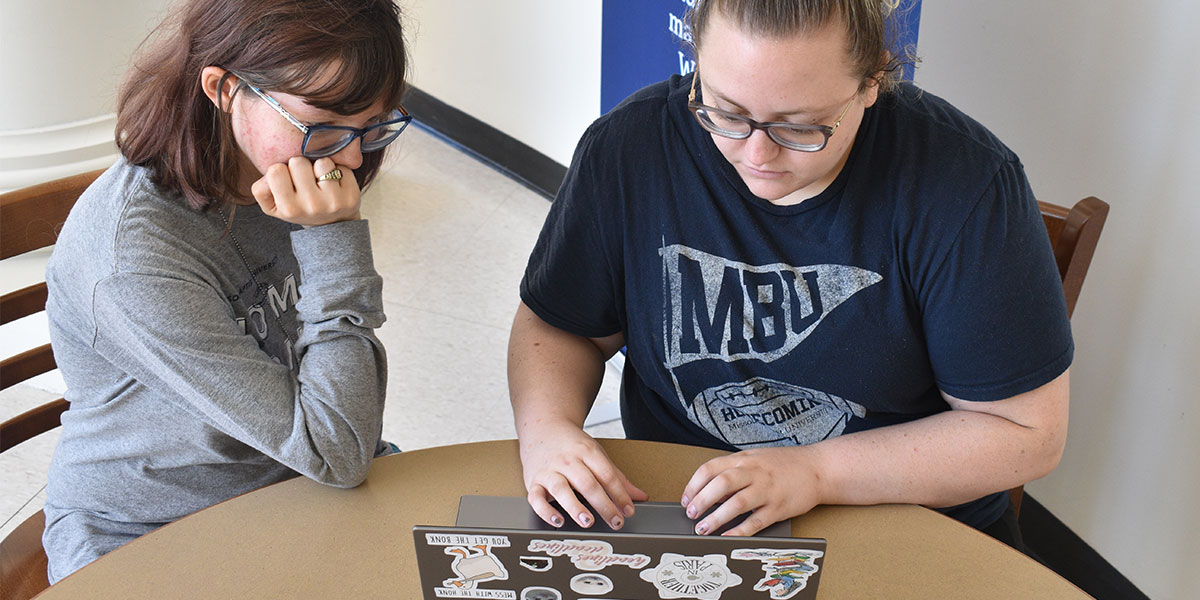Most students have taken both in-person and online classes throughout their college career, especially when we had to go online due to COVID-19. Students had to make the most of the situation, expected to learn just as much without being taught in person. So the question remains: Is online learning less effective?
Allie Pruett and Morgan Kromer, both juniors at Missouri Baptist University, studying for mid-terms. Many universities, including MBU, had distance learning options for their courses and have continued with the online format for many classes even after a return to campus. Photo by Emily Retzer
__________________________________________________
A recent study conducted by the National Center for Education Statistics found that in the fall of 2020, some 75 percent (11.8 million) of all undergraduate students were enrolled in at least one distance education course, and 44 percent (7.0 million) of all undergraduate students exclusively took distance education courses. Both methods have pros and cons, but which learning environment is more beneficial? Face-to-face learning allows you to develop meaningful relationships with teachers and peers. In the face-to-face courses I’ve taken at Missouri Baptist University, I have gotten to know my professors and peers on a deeper level. Since MBU is a small campus, developing close relationships is easier, in my opinion. You run into the same faces around campus, and you are more immersed into a learning experience in a classroom setting. There are also fewer distractions when learning face-to-face because teachers require your attention. Conversations held in a classroom can be more diverse and receive more input from classmates and teachers. Additionally, everyone is on the same lesson plan in a face-to-face classroom, so students won’t feel behind. When COVID-19 hit in the spring of 2020, schools had to either move classes online or hand out paperwork for students to complete at home. The U.S. Census Bureau conducted a Home Pulse Survey and found that nearly 93 percent of people in households with school-age children reported their children engaged in some form of “distance learning” from home, but lower-income households were less likely to rely on online resources. To many, this was a whole new ball game, having school completely online or all learning completed at home. During some online courses, you would have Zoom calls with the cameras on, allowing you to see your classmates’ and teachers’ faces. That’s where you got your “face-to-face” interaction. But if you don’t have a personal laptop, online schooling can be very difficult because all of your work is done through the virtual classroom. In the past online courses I have taken, textbooks are required and are most definitely needed because the homework is derived from the textbooks. You also have to be more on top of homework because due dates will sneak up on you, especially with assignments like reading a PowerPoint or watching videos. Having a quiet area within your own home is vital to staying focused on your work, but it is not always available. Typically, you can go at your own pace with your homework as long as you stay within the due dates set by the instructors, which I like. For some, however, it may be hard to stay on track if you aren’t organized. A new survey by Pew Research found that 65 percent of students preferred in-person instruction, compared to 18 percent who prefer a hybrid model and 9 percent who reported they’d rather learn remotely. Online courses require discipline because work is completed independently. I enjoy working independently because I know I can get the work done ahead of time and make corrections if needed. Online classes require no commuting to school, so you don’t have to worry about the weather, especially in the winter months. This is one of my favorite qualities about online courses as it saves me time and energy. I know online courses work for me, but for others, I would say face-to-face learning helps students develop more work-oriented skills, organizational skills and social skills. According to a Pennsylvanian study, only 5 percent of total online students actually finished classes, and not all who completed the courses passed. Even in universities like Harvard and MIT, course completion rates range only from 0.8 percent to 7.5 percent. There are some things that are much better when they remain unchanged, and education is one of them. Although online courses allow students to learn at their pace, they are not as valuable as traditional style learning. The teacher in the classroom not only offers students an expert process but also focused, personal attention. Overall, there are many more advantages of face-to-face classrooms because you have the opportunity to connect, problem-solve and network with other students from a wide range of backgrounds, which you can’t do as much through online courses.
